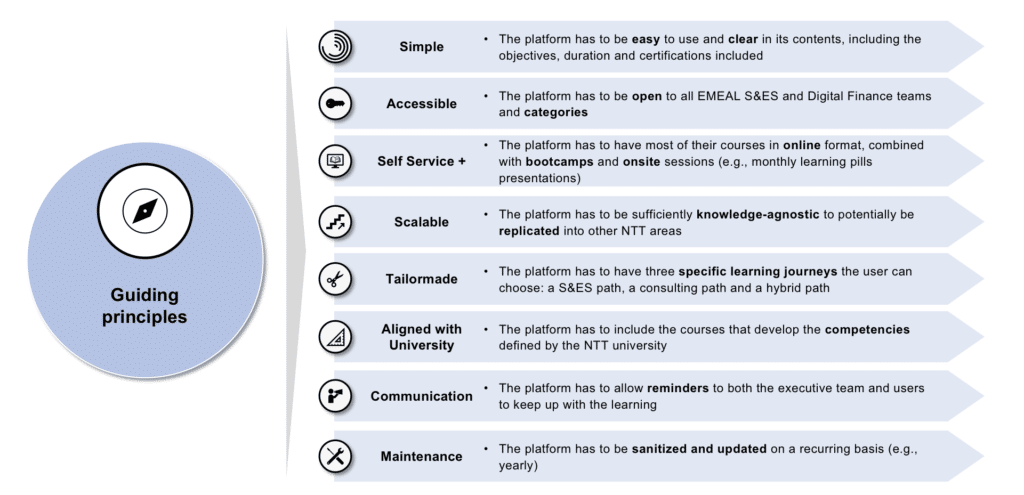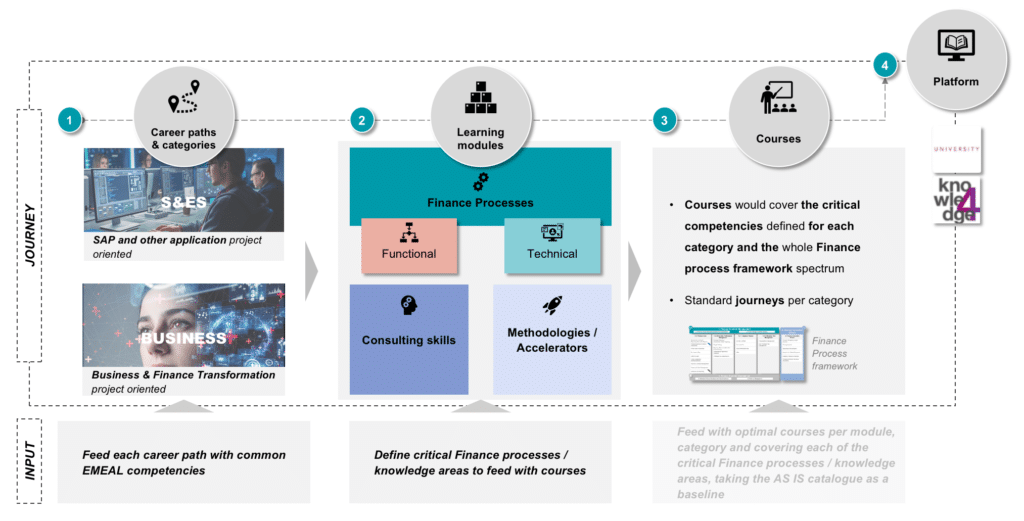Introduction
In today’s fast-paced business landscape, companies are constantly seeking ways to gain a competitive edge.
When it comes to the ever-evolving IT Sector, to meet the demands and increasing expectations of our customers it has becomes key to offer end to end services, combining in depth functional knowledge plus best practices with technology expertise on a global scale. This is one of the main market demands we address by bringing together our SAP & Enterprise Solutions (S&ES) – with our Finance Advisory Consultancy practice. Building a common knowledge base and methodology between both units is an essential pillar for success. Recognizing the importance of fostering expertise within the organization, our company embarked on the journey of setting up an Internal Finance Academy.
This article explores the benefits of establishing such an academy within NTT DATA and outlines the key steps involved in setting up the Internal Finance Academy, with a focus on creating a common learning path between the S&ES and Finance Advisory practices within the EMEAL region.
Objectives of the Finance Academy
The initiative represents a strategic move to foster knowledge sharing and standardize expertise across EMEAL, ultimately enhancing the capabilities of our workforce. The objectives of an Internal Finance Academy extend beyond traditional training. Concretely the benefits we pursue through the Finance Academy are:
1. Increase the added value of our Services for Clients
At the heart of the Internal Finance Academy lies the objective of providing our customers with more value. By investing in the development of our employees’ knowledge and skills, we ensure that we can deliver more insightful, efficient, and effective solutions to our clients.
2. Consistency in Service Delivery
Consistency is a cornerstone of reliability. Our academy’s objective is to create a shared knowledge base that fosters consistent practices and procedures across the organization. Whether you’re in one of our global offices or dealing with a local team, our clients can expect a uniform level of excellence and adherence to the best industry standards.
3. Employee Development and Growth
The growth of our employees is a direct reflection of the growth of our organization. Through our Internal Finance Academy, we are committed to providing our workforce with the tools and knowledge they need to excel in their roles. This, in turn, enhances job satisfaction and nurtures a pool of talented professionals ready to take on new challenges.
4. Tailored Knowledge
One size does not fit all, and we understand this well. Our academy ensures that employees receive tailored knowledge. This means that they, with the help of their referents can choose learning paths that align with their specific roles, expertise, and aspirations, guaranteeing that the knowledge they gain is relevant to their day-to-day tasks.
5. Enhanced Employee Performance
Investing in our employees’ growth is an investment in the performance of our organization. As they develop their skills and expertise through the academy, they become more confident, efficient, and productive. This benefits not only them but also our clients as they receive top-notch service.
6. Adaptability and Maintaining Learning Paths Updated
The IT service sector is in a constant evolution. Technological advancements, and evolving customer expectations necessitate adaptability. Our academy keeps learning paths updated, ensuring that our employees are always equipped with the latest knowledge and tools, ready to embrace change and innovation.
Key steps followed to set up the Finance Academy
Step 1: Establish a Strategic Roadmap
To launch a successful Finance Academy, the first step was to create a strategic roadmap. The roadmap outlined the path to align the SAP practice and Finance Advisory practice. Key components of the roadmap included:
• Shared Vision: The project’s foundation was a shared vision of unifying learning paths to enhance collaboration and standardize expertise among EMEAL. As a result, clear guiding principles were established.
• Agreement on a process framework for Finance.
- A) Financial processes both from a (A1) functional point of view as of a (A2) Application point of view
- B) Consulting skills
- C) Methodology skills. These objectives were defined to foster collaboration, standardization, expertise promotion, and innovation.
Guiding principles would be the foundations of the common learning platform

Step 2: Define Career Paths and Learning Journeys
The next important step was defining career paths and learning journeys for all categories of employees across EMEAL. This ensured that the Finance Academy catered to the diverse needs and aspirations of our workforce, including junior consultants and seasoned directors. Learning journeys were designed to include a mix of foundational and advanced courses.
Key components of this step included:
• Role Categorization: One of the challenges we faced was to unify and simplify the different categories of consultants, to tailor learning paths accordingly.
• Skill Mapping: We identified the skills and knowledge areas essential for each role and developed learning journeys that outlined the courses and resources needed to reach the desired proficiency.
Step 3: Engage and Share with Stakeholders
An initiative of this scale required active engagement with all relevant EMEAL stakeholders and our internal University. Sharing the project’s vision, objectives, and potential benefits was essential to garner support and participation. Engaging with stakeholders included:
• Communication Strategy: We developed a communication plan to convey the initiative’s importance and potential impact.
• Feedback Collection: We encouraged stakeholders to provide input and suggestions to shape the academy.
Step 4: Define Learning Platform Features and Governance Model
Choosing the right learning platform is crucial for the academy’s success. We carefully defined the main features required for the learning platform, emphasizing usability and progress tracking. Key considerations included:
• Usability: The platform had to be user-friendly, allowing learners of all technical backgrounds to access and navigate it effortlessly.
• Progress Tracking: We ensured that the platform could track learner progress, making it easy to monitor and adapt the curriculum as needed.
• Governance Model: The governance model outlined the roles and responsibilities of capability leaders, referents and knowledge champions ensuring smooth operation.
Step 5: Appoint Knowledge Champions
The heart of the Finance Academy lay in the development of courses. To achieve this, we appointed knowledge champions who were experts in their respective fields. These champions played a pivotal role in developing courses and ensuring their quality. They were responsible for:
• Course Development: Collaborating to design and create courses that align with the defined learning paths.
• Course Quality Assurance in collaboration with the University: Ensuring that courses met the highest standards and were up to date.
Step 6: Launch of the Academy
The following graph summarizes the methodology used to set up and develop the NTT DATA Finance Academy:
Considering the guiding principles, the learning path envisioned would be build up on four components

Conclusion
The establishment of an Internal Finance Academy is not just about education; it’s about empowerment and collaboration. By carefully defining a strategic roadmap, aligning career paths, engaging with stakeholders, selecting the right learning platform, and appointing knowledge champions, we’ve taken a significant step toward unifying learning and executing projects across EMEAL. The Finance Academy is not just a project; it’s a commitment to excellence, knowledge sharing, and the continuous growth of our talented workforce.










